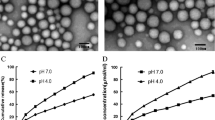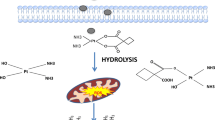Abstract
Glioblastoma is known as one of the most aggressive human cancers. To gain access of the brain, therapeutic agents must overcome blood–brain barrier (BBB). In this study, Cisplatin (Cispt)-loaded polybutylcyanoacrylate (PBCA) nanoparticles (NPs) were prepared through miniemulsion polymerization technique. They were coated with polysorbate 80 to cross the BBB of glioblastoma-bearing rats. Prepared NPs were characterized with respect to their size, size distribution, zeta potential, drug loading and encapsulation efficiency, cytotoxicity effects, drug release, and stability pattern. Size and zeta potential of nanodrug were found to be 489 nm and −20 mV, while drug loading and encapsulation efficiency were determined to be 5 % and 25 %, respectively. Release studies demonstrated high retention capability of nanodrug in that 3.18 % of Cispt was released from NPs in a period of 51 h. NPs presented acceptable stability after 2 months and lyophilization. Mean survival time in nanodrug receivers was 19.6 days, while it was 17.5 days for free drug receivers. Histological studies demonstrated efficacy of PBCA NPs in reducing side effects. Finally, such preparation can be considered as a promising nanocarrier for other types of tumor.











Similar content being viewed by others
References
Beduneau A, Saulnier P, Benoit J. Active targeting of brain tumors using nanocarriers. Biomaterials. 2007;28:4947–67.
Tian XH, Lin XN, Wei F, Feng W, Huang ZC, Wang P, et al. Enhanced brain targeting of temozolomide in polysorbate-80 coated polybutylcyanoacrylate nanoparticles. Int J Nanomedicine. 2011;6:445–52.
Chakraborty C, Sarkar B, Hsu C, Wen Z, Lin C, Shieh P. Future prospects of nanoparticles on brain targeted drug delivery. J Neurooncol. 2009;93:285–6.
Pardridge W. Blood–brain barrier delivery. Drug Discov Today. 2007;12:54–61.
Wolburg H, Lippoldt A. Tight junctions of the blood–brain barrier: development, composition and regulation. Vascul Pharmacol. 2002;38:323–37.
Masserini M. Nanoparticles for brain drug delivery. ISRN Biochem. 2013;2013:18.
Garcia-Garcia E, Andrieux K, Gilb S, Couvreur P. Colloidal carriers and blood–brain barrier (BBB) translocation: a way to deliver drugs to the brain? Int J Pharm. 2005;298:274–92.
Koffie R, Farrar C, Saidi L, William C, Hyman B, Spires-Jones T. Nanoparticles enhance brain delivery of blood–brain barrier-impermeable probes for in vivo optical and magnetic resonance imaging. Proc Natl Acad Sci U S A. 2011;108:18837–42.
Hasadsri L, Kreuter J, Hattori H, Iwasaki T, George JM. Functional protein delivery into neurons using polymeric nanoparticles. J Biol Chem. 2009;284:6972–81.
Dikpati A, Madgulkar AR, Kshirsagar SJ, Bhalekar MR, Singh Chahal A. Targeted drug delivery to CNS using nanoparticles. JAPS. 2012;2:179–91.
De Jonghe B, Horn C. Chemotherapy agent cisplatin induces 48-h Fos expression in the brain of a vomiting species, the house musk shrew (Suncus murinus). Am J Physiol Regul Integr Comp Physiol. 2009;296:902–11.
Wilson JJ, Lopes JF, Lippard SJ. Synthesis, characterization, and photophysical properties of three platinum(II) complexes bearing fluorescent analogues of the Di-2-pyridylmethane ligand. Inorg Chem. 2010;49:5303–15.
Savrikar S, Lagad C. Study of preparation and standardization of ‘Maadhutailika Basti’ with special reference to emulsion stability. Ayu. 2010;31:1–6.
Fontes G, Amaral P, Nele M, Coelho M. Factorial design to optimize biosurfactant production by Yarrowia lipolytica. J Biomed Biotechnol. 2010;2010:1–8.
Miura F, Alves M, Rocha M, Silva R, Oba-Shinjo S, Uno M, et al. Experimental model of C6 brain tumors in athymic rats Arq. Neuro-Psiquiatria. 2008;66:238–41.
Steiniger SC, Kreuter J, Khalansky AS, Skidan IN, Bobruskin AI, Smirnova ZS, et al. Chemotherapy of glioblastoma in rats using doxorubicin-loaded nanoparticles. Int J Cancer. 2004;109:759–67.
Sreelakshmi C, Datta KK, Yadav JS, Reddy BV. Honey derivatized Au and Ag nanoparticles and evaluation of its antimicrobial activity. J Nanosci Nanotechnol. 2011;11:6995–7000.
Wu L, Cai X, Nelson K, Xing W, Xia J, Zhang R, et al. A green synthesis of carbon nanoparticle from honey for real-time photoacoustic imaging. Nano Res. 2013;6:312–25.
Palanisamy KL, Meenakshi Sundaram N, Devabharathi V, Thangarasu P. Synthesis and characterization of olive oil mediated iron oxide nanoparticles. Dig J Nanomater Bios. 2013;2:607–12.
Yan X, Gemeinhart RA. Cisplatin delivery from poly (acrylic acid-co-methyl methacrylate) microparticles. J Control Release. 2005;106:198–208.
Ebrahimi Shahmabadi H, Akbarzadeh A, Mokhtari MJ, Mortazavi M, Ghasemi S, Mohammadi H, et al. In vitro evaluation of the effects of acetone, on the potency of cisplatin: is it a good candidate for cisplatin carrier preparation? E3 J Biotechnol Pharm Res. 2012;3:137–40.
Otsuka H, Nagasaki Y, Kataoka K. PEGylated nanoparticles for biological and pharmaceutical applications. Adv Drug Deliv Rev. 2012;64:246–55.
Duan J, Zhang Y, Han S, Chen Y, Li B, Liao M, et al. Synthesis and in vitro/in vivo anti-cancer evaluation of curcumin-loaded chitosan/poly (butyl cyanoacrylate) nanoparticles. Int J Pharm. 2010;400:211–20.
Macka M, Borák J, Seménková L, Kiss F. Decomposition of cisplatin in aqueous solutions containing chlorides by ultrasonic energy and light. J Pharm Sci. 1994;83:815–8.
Kante B, Couvreur P, Dubois-Krack G, De Meester C, Guiot P, Roland M, et al. Toxicity of polyalkylcyanoacrylate nanoparticles I: free nanoparticles. J Pharm Sci. 1982;71:786–90.
De Angelis LM. Brain tumours. N Engl J Med. 2001;344:114–23.
Nelson DF, Nelson JS, Davis DR, Chang CH, Griffin TW, Pajak TF. Survival and prognosis of patients with astrocytoma with atypical or anaplastic features. J Neurooncol. 1985;3:99–103.
Kornblith PL, Walker M. Chemotherapy for malignant gliomas. J Neurosurg. 1998;68:1–17.
Gao H, Yang Z, Zhang S, Cao S, Shen S, Pang Z, et al. Ligand modified nanoparticles increases cell uptake, alters endocytosis and elevates glioma distribution and internalization. Sci Rep. 2013;3:2534.
Parsa AT, Chakrabarti I, Hurley PT, Chi JH, Hall JS, Kaiser MG, et al. Limitations of the C6/Wistar rat intracerebral glioma model: implications for evaluating immunotherapy. Neurosurgery. 2000;47:993–9.
Barth R, Kaur B. Rat brain tumor models in experimental neuro-oncology: the C6, 9L, T9, RG2, F98, BT4C, RT-2 and CNS-1 gliomas. J Neurooncol. 2009;94:299–312.
Petri B, Bootz A, Khalansky A, Hekmatara T, Muller R, Uhl R. Chemotherapy of brain tumour using doxorubicin bound to surfactant-coated Poly(butyl cyanoacrylate) nanoparticles: revisiting the role of surfactants. J Control Release. 2007;117:51–8.
Olivier JC, Fenart L, Chauvet R, Pariat C, Cecchelli R, Couet W. Indirect evidence that drug brain targeting using polysorbate 80-coated polybutylcyanoacrylate nanoparticles is related to toxicity. Pharm Res. 1999;16:1836–42.
de Verdière AC, Dubernet C, Némati F, Soma E, Appel M, Ferté J, et al. Reversion of multidrug resistance with polyalkylcyanoacrylate nanoparticles: towards a mechanism of action. Br J Cancer. 1997;76:198–205.
Silver DP, Richardson AL, Eklund AC, Wang ZC, Szallasi Z, Li Q, et al. Efficacy of neoadjuvant Cisplatin in triple-negative breast cancer. J Clin Oncol. 2010;28:1145–53.
Author information
Authors and Affiliations
Corresponding authors
Rights and permissions
About this article
Cite this article
Ebrahimi Shahmabadi, H., Movahedi, F., Koohi Moftakhari Esfahani, M. et al. Efficacy of Cisplatin-loaded polybutyl cyanoacrylate nanoparticles on the glioblastoma. Tumor Biol. 35, 4799–4806 (2014). https://doi.org/10.1007/s13277-014-1630-9
Received:
Accepted:
Published:
Issue Date:
DOI: https://doi.org/10.1007/s13277-014-1630-9




